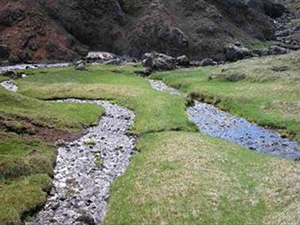 We currently characterise stream food webs and measure several whole stream ecosystem attributes: community respiration (CR), gross primary productivity (GPP), GPP/CR, nutrient cycling rate, material retention efficiency and energy transfer efficiency. We endeavour to understand how these ecosystem processes and food web respond to natural and anthropogenic pressures.
We currently characterise stream food webs and measure several whole stream ecosystem attributes: community respiration (CR), gross primary productivity (GPP), GPP/CR, nutrient cycling rate, material retention efficiency and energy transfer efficiency. We endeavour to understand how these ecosystem processes and food web respond to natural and anthropogenic pressures.
One of our study sites for this work is the Hengill geothermal area (N:64°.03, W:021°.18) in south west Iceland (near Reykjavik) - one of the most extensive geothermal fields in Iceland. High precipitation feeds the numerous streams, emerging from the mountain ridges at an elevation of 300 – 500 m altitude. These streams are primarily ground fed and with little or no influences of volcanic gases. Therefore, the water chemistry is comparable in streams with different temperatures. Ten independent streams with summer temperature range of 7 to 23 °C (see photo) were intensively studied for 4 years (2004-2007) as part of the European project Euro-limpacs (Evaluating the impacts of global change on European freshwater ecosystems, http://www.eurolimpacs.ucl.ac.uk/). The Euro-limpacs recently addressed the likelihood of increased temperatures to influence ecosystem functioning in freshwaters, including streams.
In Iceland, the research focused on several indicators of ecosystem structure and functions: food web, leaf bag decomposition, water chemistry, species diversity indices, as well as nutrient enrichment experiments in streams with different temperature. The potential effect of temperature on whole stream metabolism will be tested in summer 2008.
Our research in this area focuses on:
- Testing hypotheses related to climate change, urban treated sewage effluent, dissolved organic carbon and riparian cover.
- Conducting whole stream experiments at Glensaugh research station, comparative surveys in geothermal streams (Iceland) and streams with different riparian cover (Tarland).
Who is working in this area?
|
Updated: 23 Jan 2024, Content by: MC
|

